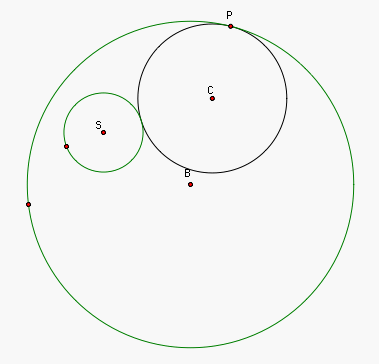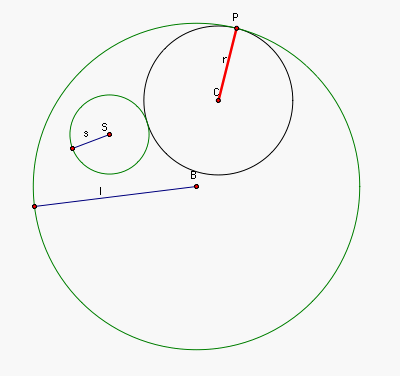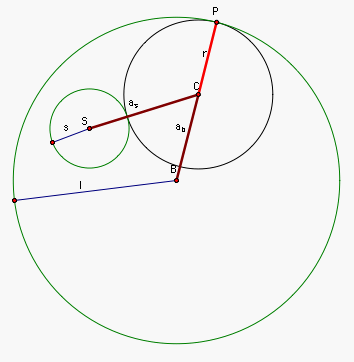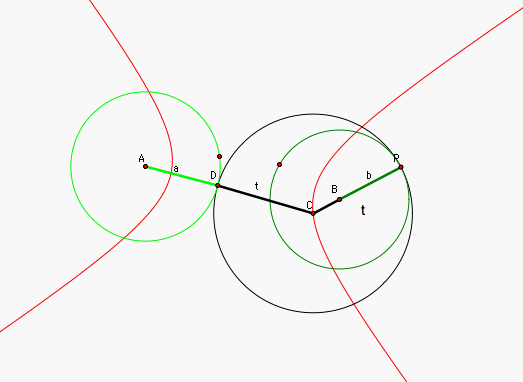Sarah
Hofmann
EMAT 6680
Summer 2006
Assignment 7
|
What I found interesting or
most helpful was the way this assignment used tangent circles to get
the students to recognize the patterns and constructions of hyperbolas
and ellipses. Unlike parabolas, which get heavy attention in all
algebra classes and above, the hyperbollic and elliptic conic sections
are often introduced and then quickly reduced to their equations.
Students don't spend much time thinking about their construction as the
locus of points that can be drawn. The concept of the hyperbola
and ellipse as a locus of points is hammered home here when we look at
the proofs for whether the locus of the tangent circles center are in
fact hyperbolic and elliptic as we hope the students would
suspect. It also gives the students a reason to study hyperbolas
and ellipses. These conic sections are not as readily seen in
nature as the parabola (or circle) and it's a nice way to give the
shapes purpose. Below we have presented our proofs for when the
locus of the centers of tangent circles are ellipses and parabolas.
|
Proof 1: We must show
that when a circle is interior to another circle and the small circle
is exterior to the tangent circle, the locus of the
centers of their tangent circle is an ellipse (in fact the cases where
there is a small circle interior to a large circle and two intersecting
circles are similar proofs).
|
We know that an ellipse is the
locus of all points x whose sum of the distances r1 from a fixed point
a and r2 from a fixed point b is constant. So we must show for
any tangent circle, the sum of the distances r1 from the center of the
small circle to the center of the tangent circle and r2 from the center
of the large circle to the center of the tangent circle is constant.
|
We will begin by drawing the
above case where there is a small circle interior to a large circle, a
point on the large circle, and we will consider the tangent circle
where the small circle is external to the tangent circle. Let S be the center of the small circle,
B the center of the big
circle, P the point of
tangency on the big circle, and C
the center of the tangent circle, as shown in the below picture.
|
Let s be the length of the radius of the
small circle, l the length of
the radius of the large circle, and r the length of the radius of the
tangent circle, as shown below.
|
Let as be the distance from the cener of
the small circle to the center of the tangent circle, and let ab be the distance from the center
of the large circle to the center of the tangent circle, as shown below.
|
Now, from the above picture and
the definitions of how we attained the tangent circle, we can see the
following facts.
as
= s + r
ab + r = l
By solving the second equation for
ab, we get
ab
= l - r
Since we need to see if the sum of the distances from the center of the
small circle to the center of the tangent circle (from S to C or as)
and from the center of the large circle to the center of the tangent
circle (from B to C or at) is constant, we need to consider
as
+ ab = (s + r) + (l - r) = s + l + r - r = s + l
But the radius of the small circle
and the radius of the large circle (s and l) are constants, hence s + l
is a constant. Therefore as + ab is a constant, which is the
desired result. Threfore, the locus of points is an ellipse, as
needed.
|
|
Proof 2: We must show that
for two non-intersecting and non-concurrent circles, the locus of the
centers of the tangent circles is a hyperbola.
|
We know that a hyperbola is the
locus of all points x whose difference of distances between x and a
foci point a and x and another foci point b is constant. So we
can show that the locus of the centers of the tangent circles is an
ellipse if we can show that the distance from the center of the tangent
circle to the center of circle one minus the distance from the tagent
circle to the center of circle two is constant.
|
Let the center of circle one
(light green) be A and its
radius be of length a, the
center of circle two (dark green) be B
and its radius be of length b,
the point of tangency on circle two be P,
the center of the tangent circle (black) be C and the length of its radius be t, and the point of tangency between
circle one and the tangent circle be point D, as shown in the below
picture. The red represents locus of all points of the points C as P travels around circle two, which
we are trying to show is a hyperbola.
|
From the above picture and from
the construction of the tangent circle we can see:
dist(AC)
= a + t
dist(CB) = t - b
So we can see
dist(AC)
- dist(CB) = (a + t) - (t - b) = a + t - t + b = a + b
where a and b are constants.
Therefore the difference of the distances from A to C and from C to B
is a constant, as needed. Therefore the locus of centers of the
tangent circles is a hyperbola, as needed.
|



